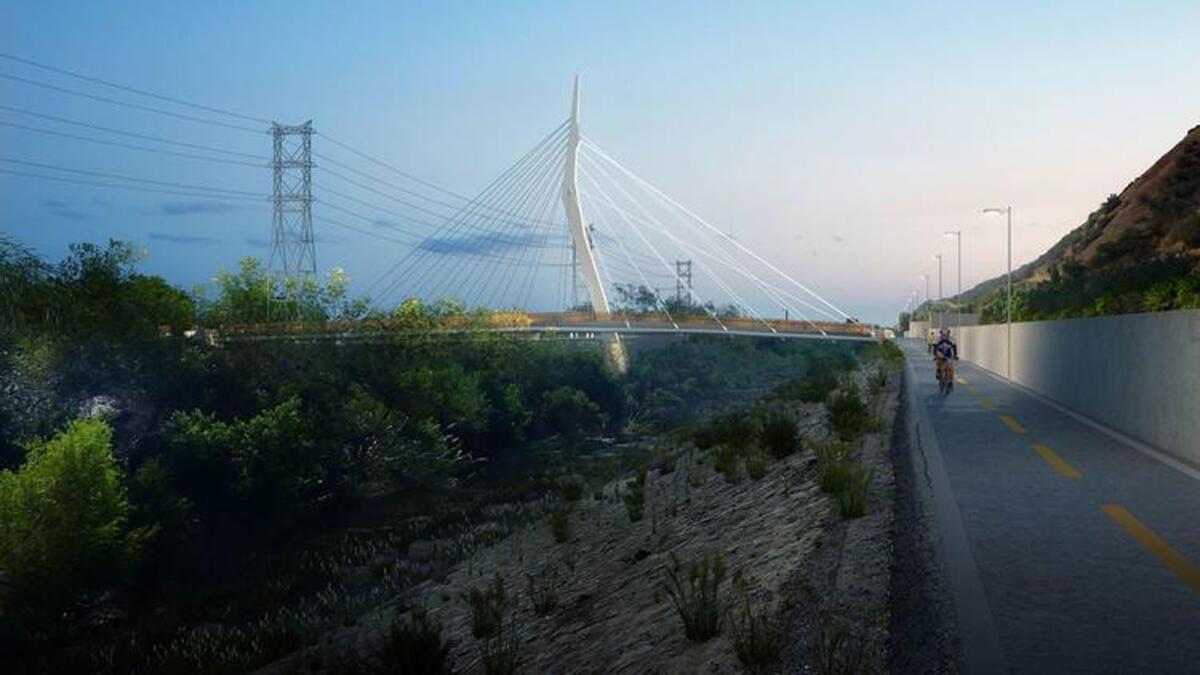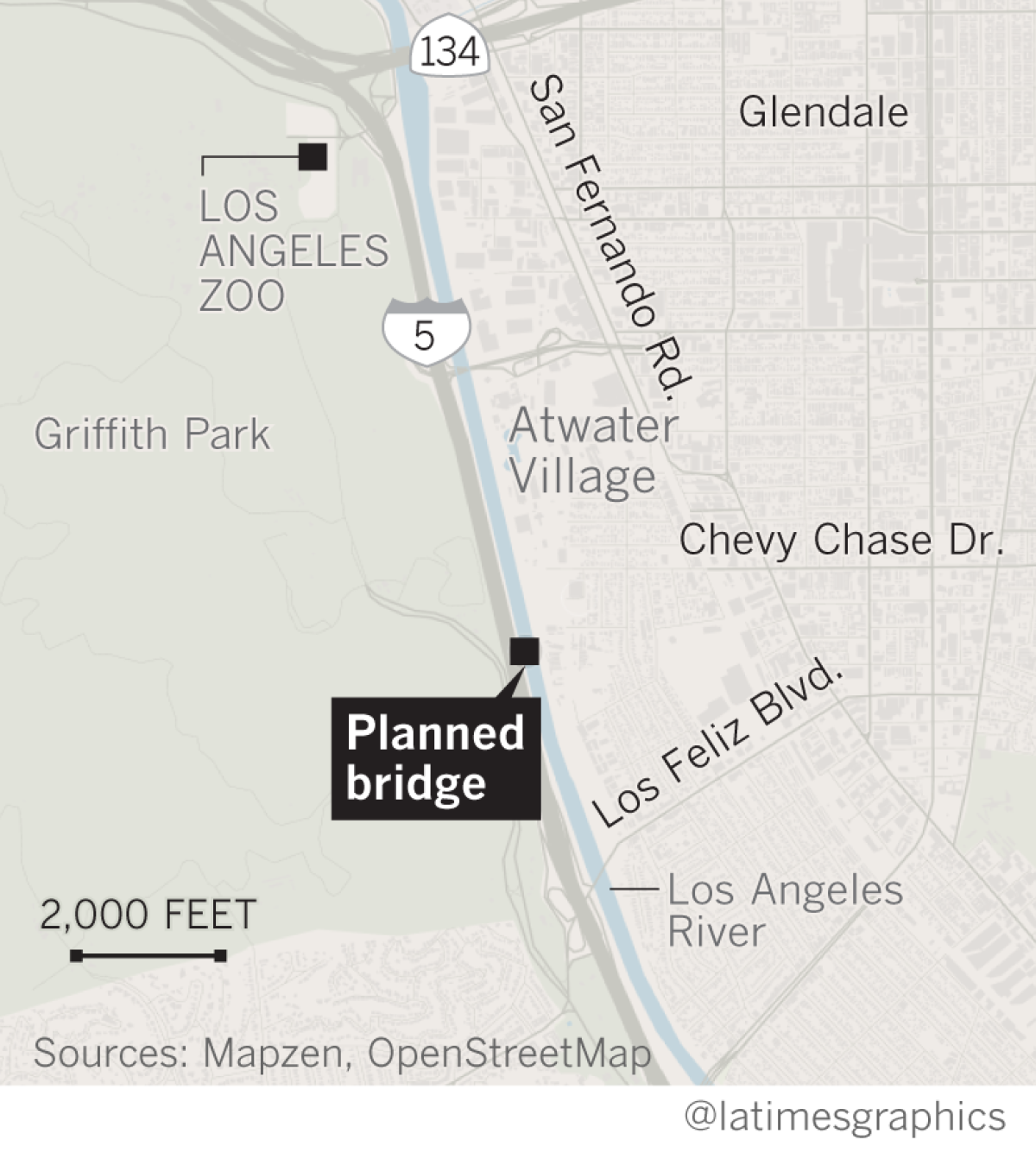How a supposedly free bridge over the L.A. River will cost taxpayers millions

- Share via
In the end, the announcement was too good to be true. L.A. was going to get a “generous gift” — a bridge across the Los Angeles River, constructed with private money.
Six years later, city leaders are ready to build the project. But it’s definitely not free. Instead, the council voted Friday to move forward with a $16.1-million “cable-stayed” steel bridge connecting Griffith Park and Atwater Village, with taxpayers shouldering about three-fourths of the cost.
The cost of the roughly 325-foot span has gone up repeatedly in the intervening years, despite nearly $3.9 million in construction funding donated by a local businessman.
Omar Brownson, executive director of the nonprofit group River LA, which raised public and private funding for the project, said construction costs went up as the economy improved. The project, which will serve pedestrians, bicyclists and horseback riders, had to be designed in a way that would not increase the flood risk, which also increased the cost, he said.
“I think that if we were just building the project for one community of folks — just for equestrians, for example — you could have built a simpler bridge,” Brownson said. “But the idea of the L.A. River is that we are trying to move away from single-purpose, single-benefit infrastructure.”
Supporters say the iconic 35-foot-wide span, which is backed by Mayor
Morton La Kretz, the philanthropist who donated $4.75 million for the project’s research, design and construction, said in a statement to The Times that the bridge will be “an asset to our city, a way to connect communities, and a symbol of river revitalization.”
Still, one city lawmaker expressed mixed feelings in recent weeks about building such an expensive project.
Councilman Mitch O’Farrell, who represents the Atwater side of the bridge, said the project began as a way of trying to help the area’s horse riders cross the river safely. The end product, he said, turned out to be somewhat more opulent than many in the neighborhood expected.
“So here we are, at this 11th hour, with a $16.12-million bridge that the community didn’t really ask for,” O’Farrell said at a hearing on the project this month.
O’Farrell voted with his colleagues to endorse the bridge-building strategy.
Word that the neighborhood was getting a new river bridge first became public in 2011. Then-Councilman

The proposal called for River LA, then known as the Los Angeles River Revitalization Corp., to design and build the structure using the money from La Kretz, whose family has been looking at developing property near the bridge site in recent years.
Permitting, inspections and other fees resulting from the project would be absorbed by the city, according to the Garcetti-LaBonge proposal. Once built, the bridge — named after La Kretz or someone chosen by him — would be turned over to the city to operate “in perpetuity,” according to the plan.
In January 2012, city budget analysts estimated the project would cost $4.67 million. Their report emphasized the bridge was “not a city project” and would be a donation to the city from River LA. At that time, the project was “fully funded,” with LaBonge’s office securing $300,000 to offset the cost of fees and other city permitting costs, the report said.
As the years passed, the price tag went up, reaching $13 million last summer. By then, River LA had brought in additional funding, including nearly $3.7 million from the California Department of Transportation. But that funding posed new challenges.
Caltrans officials concluded that River LA had followed “inadequate procurement procedures,” according to an update on the project prepared last year. To ensure the state funding would be preserved, Caltrans recommended that River LA turn construction over to the city.
By then, the city’s objective — obtaining a gift of a completed bridge — had changed. The Department of Water and Power contributed funding, as did Los Angeles County and the city’s Department of Public Works, among others.
Throughout the process, Garcetti, LaBonge and various nonprofit groups remained ardent supporters. To start over, and build a less expensive, prefabricated bridge, would jeopardize both the state funding and the donation from La Kretz, supporters argued. Such a scenario would send a “chilling effect through the philanthropic community,” one bridge advocate said.
After Friday’s vote, Garcetti spokesman George Kivork said the bridge’s costs went up, in part, as designers worked to meet the safety standards set by the U.S. Army Corps of Engineers, which has responsibility for the river’s flood control channel.
Kivork said the bridge project, part of the city’s long-range plan for the river since 2007, shows how “public-private partnerships can accelerate infrastructure development in Los Angeles.”
“The private donation from Morton La Kretz laid the groundwork to begin building a crossing for pedestrians, cyclists, and equestrians that will be safer for people and animals than crossing through the river’s channel or across major intersections near Griffith Park,” he said in a statement.
Hazel Krane, who rides horses in Atwater Village, offered a similar view on the bridge. Just last week, she broke her elbow after her horse fell in a shallow section of the riverbed.
Having a bridge would give riders a new way of reaching Griffith Park’s horse trails, she said, without riding through “a contaminated, super slippery river.”
Carrie Sutkin, who serves on the Elysian Valley Riverside Neighborhood Council, said she too welcomes the completion of the span. But she questioned whether the final cost will make it more difficult for the city to pay for riverfront projects in other neighborhoods.
“Just keep these simple,” she said. “Because we need more bridges, not less.”
Twitter: @DavidZahniser
ALSO
Off-duty LAPD officer shoots and kills dog while working security for film set downtown
The store where the pink ‘pussyhat’ began is being pushed out of Atwater Village by rising rents








